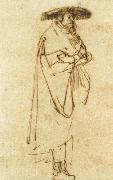Großhandels China Öl Gemälde & Rahmt Ein |
|||||||||||

|
|||||||||||
|
|
|
||||||||||||||
|
REMBRANDT Harmenszoon van Rijn
Born 1606, Died 1669 |
||||||||||||||
|
|
||||||||||||||
|
||||||||||||||
|
|
||||||||||||||
| REMBRANDT Harmenszoon van Rijn
Born 1606, Died 1669 1632-39 Ink on light-brown paper, 160 x 98 mm Musees Royaux des Beaux-Arts, Brussels Rembrandt van Rijn, the greatest Dutch painter of the 17th century, was also a highly versatile draughtsman and engraver. Most of his more than 1500 drawings were done as exercises in order to examine his subject more closely. These were possibly not intended for sale; Rembrandt kept them in portfolios, classified by subject, as part of his extensive art collection. Later they served as examples for his apprentices or as sources of inspiration for the master himself. Rarer are the autonomous drawings and studies that are directly connected with the production of paintings and engravings. Rembrandt developed the stimuli that he had gained from his teachers Jacob Isaac van Swanenburg and Pieter Lastman into a very personal and original style, as is illustrated by the present drawing. It shows a man, drawn full length and wrapped in a long, wide coat, like the one we also see in Rembrandt's drawings of Pantalone, one example of which is preserved in Hamburg, where he also wears a floppy, broad-rimmed hat with ear-muffs. Rembrandt probably studied the figure of Pantalone, the merchant in the Italian Commedia dell'arte during stage performances at the Amsterdam annual fairs. For his drawings of the actor he also worked from earlier sources such as the engravings of Jacques Callot. The Brussels sketch dates from 1632-39 and belongs to a fairly extensive group of studies of individual figures, without any decor or landscape, produced with gallnut ink on light-brown tinted paper. These are picturesquely apparelled personages such as farmers, beggars, actors and orientals with eye-catching head-dresses. Typical of these rapid sketches is the accuracy with which Rembrandt is able to capture the essence of a movement or an attitude in a few strongly posed strokes and accents. With thin, almost scratchy pen-strokes certain details are expressed in at times considerable detail - the man's eyebrows and cheekbones - whilst other parts, like his coat, are indicated in a highly summary fashion with broad lines, their effect heightened by the way in which the gallnut ink, which contained iron, has soaked into the paper. The suggestive power of these drawings, built up with fluid but carefully placed lines to form a strongly structured pattern, remains unequalled. , Artist: REMBRANDT Harmenszoon van Rijn , Man with Wide-Brimmed Hat , 1601-1650 , Dutch , graphics , study |
||||||||||||||
|
Related Paintings to REMBRANDT Harmenszoon van Rijn :. |
||||||||||||||
|
|
||||||||||||||
|
|
||||||||||||||
|
KONTAKTIEREN Sie UNS |







